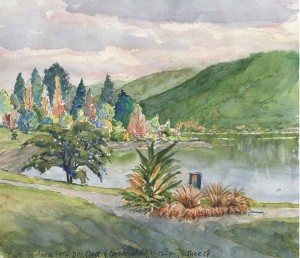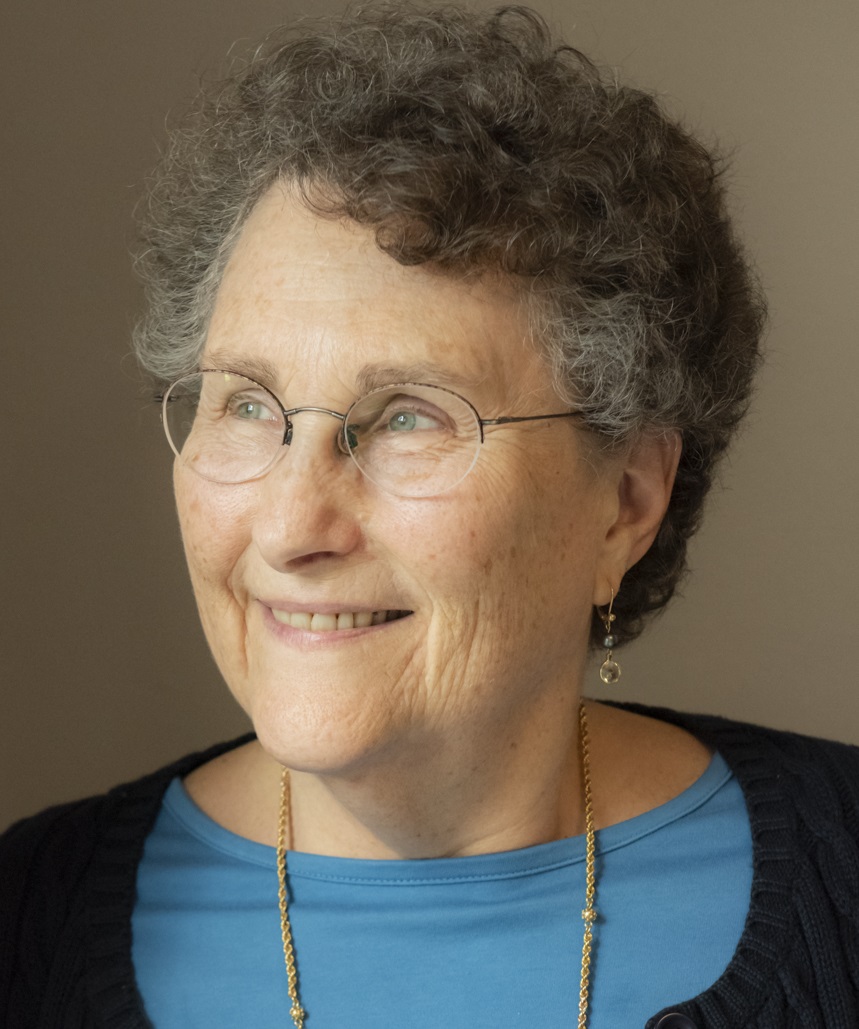Silence and prayer
Lynne Baab • Tuesday August 1 2023

When you think of praying in silence, what comes to mind? Walking in a beautiful park? The dark, quiet hours in the middle of the night? Reading a passage from the Bible and praying in response to what you read? Praying a written prayer like the one at the end of this blog post or a prayer from the Book of Common Prayer or another collection of prayers?
A month ago, when I started pondering the spiritual practices of silence and solitude as they relate to prayer, I saw silence and solitude as practices with a lot of overlap, but I wasn’t sure how to articulate how they differed. Adele Ahlberg Calhoun’s wonderful Spiritual Disciplines Handbook gave me lots of fuel for pondering. She views solitude as a “container discipline” for other practices (see my post from last week), while she considers silence to be a spiritual practice on its own. Silence, in Calhoun’s view, has healing properties, particularly when we try to attend to God’s voice and presence in silence. Notice that in her definition, reading is not a silent practice because reading involves words, and she encourages us to view silence as a time without words. The comment in parentheses in her definition comes from her, not from me. Calhoun writes:
“Silence is the regenerative practice of attending and listening to God in quiet, without interruption and without noise. Silence provides freedom from speaking as well as from listening to words or music. (Reading is also listening to words.)” [1]
For each of the spiritual practices in her book, she writes what our desire can be for this practice. For silence, she believes the desire is “to free myself from the addiction to and distraction of noise so I can be totally present to the Lord; to open myself to God in the place beyond words.” I really like the way she views silence as way to bring freedom in the midst of our addictions and distractions.
We can experience silence before God either alone or with others. Here’s where silence does not overlap with solitude. I want to tell you how I learned about this.
I am 39 years old. A woman who has been a powerful model for me is talking about the silent prayer time she attends every Friday from noon to one. She is the minister at a church in a Seattle neighborhood with five or six other churches. The ministers of those churches decided to gather on Fridays at lunchtime to pray together silently. They rotate from one church building to the next, and they invite the members of their congregations to join in. She tells me that every Friday there might be ten or twelve people there.
"What do you do in that time?" I ask.
"We meditate or pray silently," she responds.
I am incredulous. Why would you join with others to pray silently when you can do that anywhere and anytime on your own?
A year later my own church starts offering classes on contemplative prayer, various forms of silent prayer including breath prayer, guided meditations, examen, lectio divina, and centering prayer. Unlike many other Christians I talk to, from the very beginning, I find these forms of contemplative prayer to be refreshing and life-giving. My sons are 10 and 12, and our house is usually filled with intense and sometimes contentious voices, as well as the music they love. My own silent prayer times — during the many hours I experience insomnia and when I walk down to Greenlake, the lake near our house — are filled with pleas for help, as well as inner noise. Why do I struggle so much as a mother? Why am I so untidy and overweight?
I find that structured silent prayer in a group gives me two gifts: some silence in the midst of all the noise I hear at home and enough structure to quiet my mind so that I can step aside from the inner noise of self-criticism that bedevils me all too often. I decide to write an article for our church newsletter about the contemplative prayer classes, so I ask everyone to stay late and give me comments about their experience. They talk about intimacy without words. They say that they are able to pray silently so much longer and peacefully in the presence of others than they can achieve alone. They also love the depth of sharing after silent prayer together.
Ironically, silent prayer and listening to God in the form of lectio divina involves meditating on the words of scripture, so it doesn’t fit strictly into Calhoun’s emphasis on silence as freedom from words. That irony illustrates that in the areas of solitude, silence, and prayer, we cannot draw strict lines and categories. Instead, we can focus on experimenting with new forms of prayer in order to figure out what feels doable and fruitful.
I love silent prayer in the presence of others, whether that’s in a contemplative prayer class or retreat, in short silent prayer moments at church, or with my husband. And yet I don’t seek out opportunities to pray silently in groups very often anymore. Our house is quieter these days! And because I have experienced insomnia since I was pregnant with my older son, now in his early 40s, I have a lot of time to pray in silence and solitude in the middle of the night. I even have moments of gratitude for the insomnia because of the precious companionship I have experienced with Jesus when I’m awake in the wee small hours.
I encourage you to ponder the role of silence in your prayer life.
Lord of the night as well as the day, Creator of the silence of outer space and galaxies, help us notice and reflect on the patterns of silence in our lives, especially related to prayer. Please give us moments when we are renewed by attending to you in the quiet, without interruption, and without noise. Help us recognize moments when we can choose freedom from speaking as well as from listening to words or music. We ask for companions in silence at the right times. Restore our souls, we beg, and give us eyes to see the ways that prayer in silence — alone or with others — refreshes and heals us.
(This is the 12th post in a series on spiritual practices and prayer. If you’d like to learn more about spiritual practices, the first post of the series is here. That post also has a list of all the posts in the series. Illustration by Dave Baab: Lake Te Anau, New Zealand. If you’d like to receive an email when I post on this blog, sign up below under “subscribe.”)
Related posts:
[1] In the Spiritual Disciplines Handbook: Practices that Transform Us, the section on silence is pages 121-124. (Adele Alhberg Calhoun, InterVarsity Press, 2015 edition.)
Next post »« Previous post
Subscribe to updates
To receive an email alert when a new post is published, simply enter your email address below.

Lynne M. Baab, Ph.D., is a teacher and writer. She has written numerous books, Bible study guides, and articles for magazines and journals. Lynne is passionate about prayer and other ways to draw near to God, and her writing conveys encouragement for readers to be their authentic selves before God. She encourages experimentation and lightness in Christians spiritual practices. Read more »
Lynne is pleased to announce the release of her book on grief and gratitude, designed to help people grieving from anything, including the pandemic, while also desiring to notice God's good gifts. Two Hands: Grief and Gratitude in the Christian Life is available in paperback, audiobook, and for kindle. Lynne's 2018 book is Nurturing Hope: Christian Pastoral Care for the Twenty-First Century, and her best-selling book is Sabbath-Keeping: Finding Freedom in the Rhythms of Rest (now available as an audiobook as well as paperback and kindle). You can see her many other book titles here, along with her Bible study guides.
Lynne recently spoke about empathy and also about bringing spiritual practices to life.
Lynne was interviewed recently for the podcast "As the Crow Flies". The first episode focuses on why listening matters and the second one on listening skills.
Here are two talks Lynne gave on listening (recorded in audio form on YouTube): Listening for Mission and Ministry and Why Listening Matters for Mission and Ministry.
"Lynne's writing is beautiful. Her tone has such a note of hope and excitement about growth. It is gentle and affirming."
— a reader
"Dear Dr. Baab, You changed my life. It is only through God’s gift of the sabbath that I feel in my heart and soul that God loves me apart from anything I do."
— a reader of Sabbath Keeping
Subscribe
To receive an email alert when a new post is published, simply enter your email address below.
Featured posts
- Drawing Near to God with the Heart: first post of a series »
- Quotations I love: Henri Nouwen on being beloved »
- Worshipping God the Creator: the first post of a series »
- Sabbath Keeping a decade later: the first post of a series »
- Benedictine spirituality: the first post of a series »
- Celtic Christianity: the first post of a series »
- Holy Listening »
- A Cat with a Noble Character »
- Welcome to my website »
Tags
Archive
- April 2024 (4)
-
March 2024 (5)
- Friendship, loneliness, and prayer: Praying about distractions from empathy
- Friendship, loneliness, and prayer: Praying to keep empathy flowing
- Friendship, loneliness, and prayer: Everyday initiative
- Friendship, loneliness, and prayer: Praying for guidance for ending conversations
- Friendship, loneliness, and prayer: Reflecting on the series
- February 2024 (4)
- January 2024 (2)
-
December 2023 (6)
- Friendship, loneliness, and prayer: Initiating
- Friendship, loneliness, and prayer: Praying about listening roadblocks
- Friendship, loneliness, and prayer: Praying to love the poverty in our friends
- Friendship, loneliness, and prayer: Praying for “holy curiosity”
- Friendship, loneliness, and prayer: Praying for “holy listening”
- Friendship, loneliness, and prayer: Praying to give affection extravagantly
- November 2023 (4)
-
October 2023 (5)
- Friendship, loneliness and prayer: A listening skill with two purposes
- Friendship, loneliness, and prayer: Saying “thank you” to friends
- Friendship, loneliness, and prayer: One more way reflecting helps us
- Friendship, loneliness, and prayer: Lessons from two periods of loneliness
- Friendship, loneliness, and prayer: Types of reflecting, a listening skill
- September 2023 (4)
- August 2023 (4)
- July 2023 (5)
- June 2023 (3)
- May 2023 (6)
- April 2023 (4)
- March 2023 (4)
- February 2023 (4)
- January 2023 (4)
- December 2022 (5)
- November 2022 (1)
- October 2022 (5)
- September 2022 (5)
-
August 2022 (6)
- Draw near: Confessing sin without wallowing
- Draw near: A favorite prayer about peace, freedom, and much more
- Drawing near with Desmond Tutu: God’s love is the foundation for prayer
- Draw near: Worshipping God with Desmond Tutu
- Draw near: Yearning, beseeching and beholding with Desmond Tutu
- Draw near: Praising God with Desmond Tutu
- July 2022 (2)
- June 2022 (6)
- May 2022 (5)
- April 2022 (6)
- March 2022 (5)
- February 2022 (4)
- January 2022 (3)
- December 2021 (5)
- November 2021 (4)
- October 2021 (5)
- September 2021 (4)
- August 2021 (4)
- July 2021 (4)
- June 2021 (4)
- May 2021 (4)
- April 2021 (5)
- March 2021 (4)
- February 2021 (4)
- January 2021 (4)
- December 2020 (5)
- November 2020 (3)
- October 2020 (5)
- September 2020 (4)
- August 2020 (4)
- July 2020 (5)
- June 2020 (4)
-
May 2020 (4)
- Spiritual diary of sheltering in place: The lifeline of separating thoughts from feelings
- Spiritual diary of sheltering in place: The lifeline of welcoming prayer
- Spiritual diary of sheltering in place: a kite string as a lifeline
- Spiritual diary of sheltering in place: The lifeline of God’s distant future
-
April 2020 (7)
- Spiritual diary of self-isolation: the lifeline of God’s constancy
- Spiritual diary of sheltering in place: The lifeline of accepting my place as a clay jar
- Spiritual diary of sheltering in place: the lifeline of memories
- Spiritual diary of sheltering in place: the lifeline of “Good” in “Good Friday”
- Spiritual diary of sheltering in place: The lifeline of “easier does not mean easy”
- Spiritual diary of sheltering in place: The lifeline of nature
- Spiritual diary of sheltering in place: the lifeline of God’s voice through the Bible
-
March 2020 (7)
- Important anniversaries in 2020: The first Earth Day in 1970
- Important anniversaries in 2020: Florence Nightingale was born in 1820
- Spiritual diary of self-isolation: Weeks 1 and 2
- Spiritual diary of self-isolation: God's grace as a lifeline
- Spiritual diary of self-isolation: The lifeline of limits on thoughts
- Spiritual diary of self-isolation: Wrestling with God for a blessing
- Spiritual diary of self-isolation: responding to terror by listening to Jesus voice
- February 2020 (4)
- January 2020 (5)
- December 2019 (4)
- November 2019 (4)
- October 2019 (5)
- September 2019 (4)
- August 2019 (5)
- July 2019 (4)
- June 2019 (4)
- May 2019 (5)
- April 2019 (4)
- March 2019 (4)
- February 2019 (4)
-
January 2019 (5)
- Nurturing friendships in a cellphone world: Jesus as Friend
- Nurturing friendships in a cellphone world: Friendship with Christ and friendship with others
- Nurturing friendships in a cellphone world: Who is my neighbor?
- Nurturing friendships in a cellphone world: Friendship as action
- Nurturing friendships in a cellphone world: Hymns that describe friendship with God
- December 2018 (3)
-
November 2018 (5)
- Connections between the Bible and prayer: Sensory prayer in Revelation
- First post in a new series: Nurturing friendships in a cellphone world
- Nurturing friendships in a cellphone world: Strong opinions and responses
- Nurturing friendships in a cellphone world: My conversation partners about friendship
- Nurturing friendships in a cellphone world: Two views about communication technologies
- October 2018 (4)
- September 2018 (4)
-
August 2018 (5)
- Providing Christian Care in Our Time
- Providing Christian care in our time: Seven trends in pastoral care today
- Providing Christian Care in Our Time: Skills for Pastoral Care
- Providing Christian care: The importance of spiritual practices
- First post in a new series: Connections between the Bible and prayer
- July 2018 (4)
- June 2018 (4)
- May 2018 (5)
- April 2018 (4)
- March 2018 (5)
- February 2018 (4)
- January 2018 (4)
- December 2017 (5)
- November 2017 (4)
- October 2017 (4)
- September 2017 (5)
- August 2017 (4)
- July 2017 (4)
- June 2017 (4)
-
May 2017 (5)
- My new spiritual practice: Separating thoughts from feelings
- My new spiritual practice: Feeling the feelings
- My new spiritual practice: Coping with feelings that want to dominate
- My new spiritual practice: Dealing with “demonic” thoughts
- My new spiritual practice: Is self-compassion really appropriate for Christians?
- April 2017 (4)
- March 2017 (5)
- February 2017 (4)
- January 2017 (4)
- December 2016 (5)
- November 2016 (4)
- October 2016 (4)
- September 2016 (5)
- August 2016 (4)
- July 2016 (4)
- June 2016 (4)
- May 2016 (5)
- April 2016 (4)
- March 2016 (5)
- February 2016 (4)
- January 2016 (4)
- December 2015 (4)
- November 2015 (4)
- October 2015 (5)
- September 2015 (4)
- August 2015 (4)
- July 2015 (4)
- June 2015 (4)
- May 2015 (4)
- April 2015 (6)
- March 2015 (4)
- February 2015 (4)
- January 2015 (4)
- December 2014 (5)
- November 2014 (4)
- October 2014 (4)
- September 2014 (4)
- August 2014 (5)
- July 2014 (4)
- June 2014 (7)





















